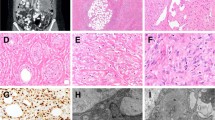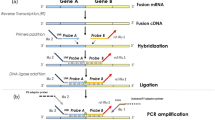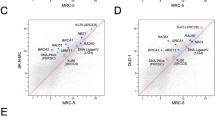Abstract
The SYT–SSXI and SYT–SSX2 fusion genes, derived by reciprocal translocations t(X;18), are acquired genetic events strongly associated with the tumorigenesis of synovial sarcoma. In approaching the mechanisms underlying the formation of these fusion oncogenes, we have analysed the genomic sequences surrounding the SYT–SSX breakpoints in 10 tumors, two expressing SYT–SSXI and eight expressing SYT–SSX2 fusion transcripts. The breakpoints were found to be clustered in the 5′ end of intron 10 of SYT, and in two cluster regions within intron 4 of SSX2, whereas the two breakpoints in SSX1 intron 4 were 0.5 kb apart. SYT intron 10 is abundant in repetitive regions with the interspersed repeats occupying 66% of the whole intron. Nine of the 10 breakpoints in intron 10 of SYT and six of the eight breakpoints in intron 4 of SSX2 were at or near repetitive regions. These findings suggest that repetitive regions may contribute to the distribution of genomic breakpoints. Several of the fusion sequences exhibited characteristic signs of nonhomologous end joining, including microhomologies at the end points as well as deletions. Sequences highly homologous (83–94%) to consensus topoisomerase II cleavage sites were identified at or near the breakpoints in all 10 tumors, suggesting a role of this enzyme in creating staggered ends at the breakpoint. Furthermore, sequences highly homologous to consensus Translin binding sequences were found at the breakpoints in two cases, and an Alu–Alu fusion and an insertion of a 206-bp LINE-1 element were found at the breakpoint in one case each. The demonstration of characteristic sequences at the SYT–SSX breakpoint regions is expected to improve our understanding of the molecular genetic mechanisms behind translocations in general, and of the SYT–SSX fusions in synovial sarcoma in particular.
This is a preview of subscription content, access via your institution
Access options
Subscribe to this journal
Receive 50 print issues and online access
$259.00 per year
only $5.18 per issue
Buy this article
- Purchase on Springer Link
- Instant access to full article PDF
Prices may be subject to local taxes which are calculated during checkout



Similar content being viewed by others
References
Aoki K, Suzuki K, Sugano T, Tasaka T, Nakahara K, Kuge O, Omori A and Kasai M . (1995). Nat. Genet., 10, 167–174.
Barr FG, Nauta LE and Hollows JC . (1998). Cancer Genet. Cytogenet., 102, 32–39.
Boehm T, Mengle-Gaw L, Kees UR, Spurr N, Lavenir I, Forster A and Rabbitts TH . (1989). EMBO J., 8, 2621–2631.
Broeker PL, Super HG, Thriman MJ, Pomykala H, Yonebayashi Y, Tanabe S, Zeleznik-Le N and Rowley JD . (1996). Blood, 87, 1912–1922.
Bullock P, Champoux JJ and Botchan M . (1985). Science, 230, 954–958.
Camerini-Otero RD and Hsieh P . (1993). Cell, 73, 217–223.
Chalk JG, Barr FG and Mitchell CD . (1997). Oncogene, 15, 1199–1205.
Chen SJ, Chen Z, d'Auriol L, Le Coniat M, Grausz D and Berger R . (1989). Oncogene, 4, 195–202.
Clark J, Rocques PJ, Crew AJ, Gill S, Shipley J, Chan AML, Gusterson BA and Cooper CS . (1994). Nat. Genet., 7, 502–508.
Crew AJ, Clark J, Fisher C, Gill S, Grimer R, Chand A, Shipley J, Gusterson BA and Cooper CS . (1995) EMBO J., 14, 2333–2340.
de Leeuw B, Balemans M, Olde Weghuis D and Geurts van Kessel A . (1995). Hum. Mol. Genet., 4, 1097–1099.
Finger LR, Harvey RC, Moore RC, Showe LC and Croce CM . (1986). Science, 234, 982–985.
Hosaka T, Kanoe H, Nakayama T, Murakami H, Yamamoto H, Nakamata T, Tsuboyama T, Oka M, Kasai M, Sasaki M, Nakamura T and Toguchida J . (2000). Oncogene, 19, 5821–5825.
Ishida S, Yoshida K, Kaneko Y, Tanaka Y, Sasaki Y, Urano F, Umezawa A, Hata J and Fujinaga K . (1998). Cytogenet. Cell Genet., 82, 278–283.
Kanoe H, Nakayama T, Hosaka T, Murakami H, Yamamoto H, Nakashima Y, Tsuboyama T, Nakamura T, Ron D, Sasaki MS and Toguchida J . (1999). Oncogene, 18, 721–729.
Kas E and Laemmli UK . (1992). EMBO J., 11, 705–716.
Kolomietz E, Meyn MS, Pandita A and Squire JA . (2002). Genes Chromosomes Cancer, 35, 97–112.
Krowczynska AM, Rudders RA, Krontiris TG, de Klein A, van Agthoven T, Groffen C, Heisterkamp N, Groffen J and Grosveld G . (1986). Nucleic Acids Res., 14, 7071–7082.
Ladanyi M . (1995). Diagn. Mol. Pathol., 4, 162–173.
Liu J, Nau MM, Zucman-Rossi J, Powell JI, Allegra CJ and Wright JJ . (1997). Genes Chromosomes Cancer, 18, 232–239.
Lovett BD, Lo Nigro L, Rappaport EF, Blair IA, Osheroff N, Zheng N, Megonigal MD, Williams WR, Nowell PC and Felix CA . (2001). Proc. Natl. Acad. Sci. USA, 98, 9802–9807.
Nicholls RD, Fischel-Ghodsian N and Higgs DR . (1987). Cell, 49, 369–378.
Nilsson G, Skytting B, Xie Y, Brodin B, Perfekt R, Mandahl N, Lundeberg J, Uhlen M and Larsson O . (1999). Cancer Res., 59, 3180–3184.
Panagopoulos I, Lassen C, Isaksson M, Mitelman F, Mandahl N and Åman P . (1997). Oncogene, 15, 1357–1362.
Rabbitts TH . (1994). Nature, 372, 143–149.
Sambrook J, Fritsch EF and Maniatis T . (1989). Molecular Cloning: a Laboratory Manual, 2nd edn. Cold Spring Harbor Laboratory Press: Cold Spring Harbor Laboratory, Cold Spring Harbor, NY.
Sander M and Hsieh T . (1985). Nucleic Acids Res., 13, 1057–1072.
Skytting B, Nilsson G, Brodin B, Xie Y, Lundeberg J, Uhlen M and Larsson O . (1999). J. Natl. Cancer Inst., 91, 974–975.
Sorensen PH and Triche TJ . (1996). Semin. Cancer Biol., 7, 3–14.
Sowerby SJ, Kennedy MA, Fitzgerald PH and Morris CM . (1993). Oncogene, 8, 1679–1683.
Sperry AO, Blasquez VC and Garrad WT . (1989). Proc. Natl. Acad. Sci. USA, 86, 5497–5501.
Spitzner JR and Muller M . (1988). Nucleic Acids Res., 16, 5533.
Sreekantaiah C, Ladanyi M, Rodriguez E and Chaganti RSK . (1994). Am. J. Pathol., 144, 1121–1134.
Toth G and Jurka J . (1994). Gene, 140, 285–288.
Villablanca A, Wassif WS, Smith T, Höög A, Vierimaa O, Kassem M, Dwight T, Forsberg L, Du Q, Learoyd D, Jones K, Stranks S, Juhlin C, Teh BT, Carling T, Robinson B and Larsson C . (2002). Eur. J. Endocrinol., 147, 313–322.
Weiss SW and Goldblum JR . (2001). Soft Tissue Tumors, 4th edn. Mosby: St Louis.
Zhang Y, Strissel P, Strick R, Chen J, Nucifora G, Le Beau MM, Larson RA and Rowley JD . (2002). Proc. Natl. Acad. Sci. USA, 99, 3070–3075.
Zucman-Rossi J, Legoix P, Victor JM, Lopez B and Thomas G . (1998). Proc. Natl. Acad. Sci. USA, 95, 11786–11791.
Acknowledgements
This work was supported by the Committee of Science and Technology, Shanghai, China, the Swedish Cancer Foundation, the Torsten and Ragnar Söderberg Foundations, and the Wenner-Gren Foundation.
Author information
Authors and Affiliations
Rights and permissions
About this article
Cite this article
Wei, Y., Sun, M., Nilsson, G. et al. Characteristic sequence motifs located at the genomic breakpoints of the translocation t(X;18) in synovial sarcomas. Oncogene 22, 2215–2222 (2003). https://doi.org/10.1038/sj.onc.1206343
Received:
Revised:
Accepted:
Published:
Issue Date:
DOI: https://doi.org/10.1038/sj.onc.1206343
Keywords
This article is cited by
-
Primary pleuropulmonary and mediastinal synovial sarcoma: a clinicopathologic and molecular study of 26 genetically confirmed cases in the largest institution of southwest China
Diagnostic Pathology (2016)
-
Synovial sarcoma is a gateway to the role of chromatin remodeling in cancer
Cancer and Metastasis Reviews (2015)
-
Identification of SYT-SSX transcripts from synovial sarcomas using RT-multiplex PCR and capillary electrophoresis
Modern Pathology (2006)



